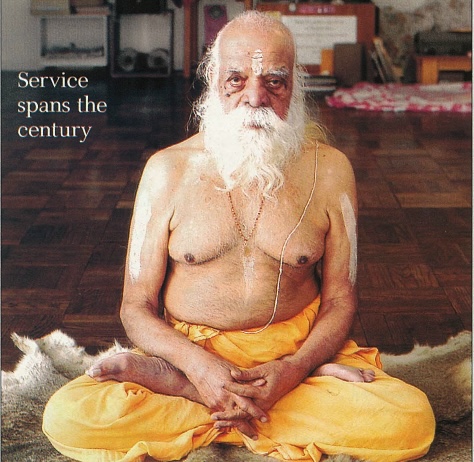We intended to interview Swami Bua at length in honor of his winning the 1998 Hindu Renaissance Award as “Hindu of the Year,” but with his schedule, it was difficult to get more than a short fax from him. We thought he’d slow down a bit at his age–109–but he proved more kinetic than a campaigning pol. As we write, tomorrow he leaves for a return three-month visit to South America at the invitation of devotees and scholars.
Starting in 1990, Hinduism Today has honored one saint each year who has most impacted the faith and spread its values, compassion and profundity across the globe. Past renaissance winners are: Swami Paramananda Bharati (’90), Swami Chidananda Saraswati (’91), Swami Chinmayananda (’92), Mata Amritanandamayi (’93), Swami Satchidananda (’94), Pramukhaswami Maharaj (’95), Sri Satya Sai Baba (’96) and Sri Chinmoy (’97). For his long life of service and continuing pioneering work for the Hindu dharma in South America and elsewhere, Swami Bua was the choice for 1998.
Swami won’t reveal his age or anything else that is personal about himself, and there is no independent verification for his devotees’ claim. But Hinduism Today publisher Satguru Sivaya Subramuniyaswami first met Swami in Paris in 1969, and Swami was at that time easily in his 70s. Then, as now, this accomplished hatha yogi was in the best of shape, able to blow a conch for several minutes without taking a breath. His intellect and sense of humor remain keen. [See his Minister’s Message, page 52, on longevity.] During his long life, he has met Swami Sivananda (in 1930), Mahatma Gandhi, Rabindranatha Tagore, Theosophist Annie Besant and Subramuniyaswami’s guru, Siva Yogaswami of Jaffna, Sri Lanka.
Swami has lived alone since 1972 in a modest apartment in New York City near Central Park. The living room is his yoga classroom where small groups of students gather daily for instruction in hatha yoga and meditation. Though he lives on a mostly liquid diet of vegetable and fruit juice, Swami loves to cook. When last we called him for this article, Swami Sahakradharananda from Nepal had just arrived to visit, and Swami had to end our conversation to prepare dosai for his guest.
He won’t say much about his past, except to tell one story from his childhood. “I was the 16th child of my parents, having 12 brothers and 4 sisters,” he said in a 1982 interview with Hinduism Today. “I was born crippled and remained so until I was ten. Then a doctor predicted I would die. I did die, or so they thought. They took me to the cremation ground and put my body on the pyre. As the flames were lit, my body began to shake. Everyone ran away. Only one sadhu named Yogeshwara stayed, and he took me off the fire, then to his ashram where he gave me Himalayan herbs and taught me yoga. By 17 I had regained my health, but my family would not take me back.” Swami has lived as a strict sannyasi ever since.
“No special practice is necessary for God Realization,” he told us. “I see God everywhere. If God is not there, how do so many things happen?” “My contention is that sickness is sin,” Swami went on. “Don’t kill other animals, don’t make the belly as a burial ground. I teach hatha yoga, but I don’t subscribe to the idea that hatha yoga is a physical gymnastic exercise. ‘Restraint of the modifications of the mind’ [according to Patanjali] is yoga. Altogether there are eight limbs. Yama, moral restraints, is a step. When are you going to perfect your yama? How many lives is it going to take? When are you going to perfect your niyama, spiritual observances? When are you going to perfect your pratyahara, drawing in the forces of the mind? It takes time.” And so has Swami been direct and outspoken throughout his life, and well deserved to be named “Hindu of the Year” in 1998.
SRI SWAMI BUA JI MAHARAJ, 330 WEST 58TH STREET #11J, NEW YORK, NEW YORK 10019 USA


